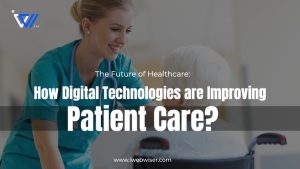How Healthcare Organizations Can Save Money Through Digital Transformation?
September 15, 2023


Digital transformation has become a buzzword in almost every industry, including healthcare. In an era where technology is advancing at an unprecedented rate, healthcare organizations are embracing digital transformation to improve patient care, streamline operations, and reduce costs. In this article, we will explore the various aspects of digital transformation in healthcare and how it can help organizations save money.
Understanding Digital Transformation in Healthcare
In today’s rapidly evolving world, digital transformation has become a buzzword across various industries, and healthcare is no exception. The integration of digital technologies into all areas of healthcare organizations is fundamentally changing how they operate and deliver value to patients. Digital transformation in healthcare involves leveraging technology to improve efficiency, patient outcomes, and the overall patient experience.
Definition of Digital Transformation
Digital transformation refers to the process of adopting and integrating digital technologies into the core operations of healthcare organizations. It encompasses a wide range of technologies, including electronic health records (EHRs), telemedicine, artificial intelligence (AI), internet of things (IoT), and data analytics. These technologies enable healthcare providers to streamline processes, enhance decision-making, and deliver personalized care to patients.
With digital transformation, healthcare organizations can move away from traditional paper-based systems and embrace digital tools that enable seamless communication, collaboration, and data sharing among healthcare professionals. This shift not only enhances operational efficiency but also improves patient safety, reduces medical errors, and ensures better coordination of care.
The Current State of Digital Transformation in Healthcare
While digital transformation has been a prevalent trend across industries, the healthcare sector has been relatively slow in adopting these advancements. However, recent years have witnessed a significant increase in the adoption of digital technologies in healthcare organizations.
According to a study conducted by McKinsey, healthcare organizations that have embraced digital transformation have outperformed their peers in terms of revenue growth and cost savings. These organizations have realized the potential of digital technologies to drive innovation, improve patient outcomes, and optimize resource utilization.
One of the key factors driving the adoption of digital transformation in healthcare is the growing demand for accessible and convenient healthcare services. iwebwiser help digital technologies, such as telemedicine and mobile health applications, enable patients to access healthcare remotely, eliminating the need for in-person visits. This not only improves patient convenience but also reduces healthcare costs and enhances access to care, particularly for individuals residing in remote areas.
Furthermore, digital transformation in healthcare has revolutionized the way medical data is collected, stored, and analyzed. Electronic health records (EHRs) have replaced traditional paper-based records, enabling healthcare providers to access patient information in real-time, make informed decisions, and provide personalized care. Additionally, advanced analytics tools allow healthcare organizations to leverage big data and derive valuable insights for disease prevention, early detection, and treatment optimization.
As the healthcare industry continues to embrace digital transformation, there are still challenges that need to be addressed. These include concerns about data privacy and security, interoperability issues among different systems, and the need for appropriate training and education for healthcare professionals to effectively utilize digital technologies.
Digital transformation in healthcare is a dynamic and ongoing process that aims to leverage digital technologies to improve patient care, enhance operational efficiency, and drive innovation. The current state of digital transformation in healthcare shows promising results, with organizations at the forefront experiencing significant benefits. However, there is still much work to be done to overcome challenges and fully realize the potential of digital transformation in revolutionizing the healthcare industry.
The Financial Impact of Digital Transformation
Digital transformation has become a crucial aspect of healthcare organizations in recent years. Not only does it bring about advancements in technology, but it also has a significant financial impact. Let’s explore some of the ways in which digital transformation can lead to both cost savings and revenue growth.
Cost Savings from Streamlined Operations
One of the key benefits of digital transformation in healthcare is the ability to streamline operations and reduce costs. By digitizing processes and automating repetitive tasks, healthcare organizations can save both time and money.
Take, for example, the implementation of electronic health records (EHRs). This digital system eliminates the need for manual paper-based record-keeping, reducing administrative costs and improving data accuracy. With EHRs, healthcare professionals can access patient information quickly and efficiently, leading to enhanced productivity and reduced operational expenses.
Furthermore, digital transformation enables the implementation of advanced analytics and data-driven decision-making. By leveraging data analytics tools, healthcare organizations can identify areas of inefficiency and optimize resource allocation. This not only improves operational efficiency but also helps in cost reduction by eliminating unnecessary expenditures.
Revenue Growth from Enhanced Patient Services
Digital transformation goes beyond just cost savings. It can also drive revenue growth by improving patient services. By embracing digital technologies, healthcare organizations can enhance the overall patient experience, resulting in increased revenue.
One such example is telemedicine, which has gained significant popularity in recent years. Telemedicine enables healthcare organizations to reach a larger patient population, regardless of geographical barriers. By offering remote consultations and monitoring, healthcare providers can expand their services and generate additional income.
Moreover, digital transformation allows for the development of personalized patient experiences. By leveraging data and analytics, healthcare organizations can gain valuable insights into patient preferences and behaviors. This information can be used to tailor services and treatments, resulting in improved patient satisfaction and loyalty. Satisfied patients are more likely to recommend the healthcare organization to others, leading to an increase in patient referrals and subsequently, revenue growth.
Digital transformation in healthcare has a profound financial impact. By streamlining operations and reducing costs, healthcare organizations can achieve significant savings. Simultaneously, by enhancing patient services and utilizing data-driven decision-making, revenue growth opportunities arise. It is clear that digital transformation is not only a technological advancement but also a strategic move towards financial success in the healthcare industry.


